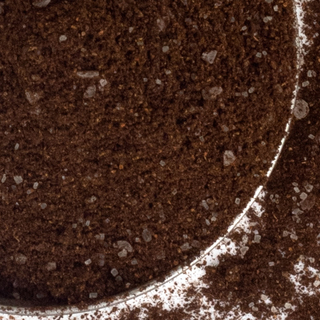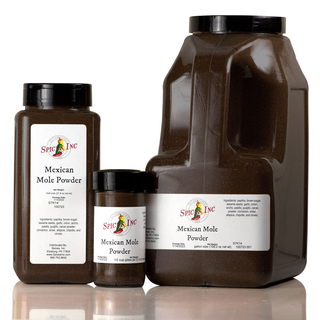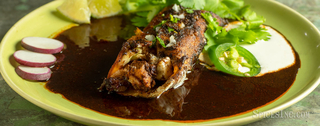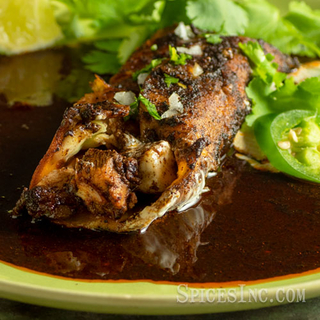Mexican Mole Powder




Mexican Mole Powder
What Is Mole Powder
Mexican Mole Powder (pronounced “mo-lay"), is also called mole seasoning, mole spice, or mole spice mix.
Mole comes from a family of rich, spicy sauces prepared throughout the Oaxaca and Puebla regions of Mexico and all mole sauces have a unique flavor. Some are spicier, others are sweeter, but they should all have a complex thick sauce and should never be runny. All moles have varying levels of spicy, smoky, and earthy-sweet notes from a complex, layered blend of chiles, spices, dried fruits, and seasonings. Mole powder is simply an easily acceptable way to add all the flavors of mole as one convenient to add ingredient. This time saving step is important given that moles are notorious for having a high number of ingredients. Moles typically have between 6 and 20 ingredients with some mole recipes calling for up to 31.
Most mole recipes call for more than one variety of chile pepper and this is one of the signature qualities of mole with the most common chiles being Mulato, Ancho, and Pasilla but may also include Costeno, Cascabel, and Guajillo. The most popular spices used include Black Pepper, Canela Cinnamon, Sesame Seed, Anise Seed, and Clove. Other ingredients include tomatoes, tortillas, raisins, garlic, almonds, pepitas, and peanuts. Contrary to many internet sources Cacao, or chocolate, is not found in all moles. While not present in all moles cacao is probably the best known mole ingredient worldwide.
The spices are roasted and ground into a fine powder or paste. This roasting and grinding process has traditionally been extremely laborious and can take up to a day to complete by hand. Mole recipes vary greatly from region to region and many families have their own recipes of mole which are passed down from generation to generation. Because of the long prep time moles are generally reserved for special occasions and are made in large batches.
What Does Mole Powder Taste Like
Earthy, nutty, with noticeable fruitiness and hints of chocolate.
How to Use Mole Powder
Mole--the dish--is typically served with tortillas or rice and the thick mole sauce is served over turkey, chicken, and seafood. But Mexican cuisine is expansive and versatile, and you can also find moles made with beef, frog legs, and pork. Turkey is the most traditional meat with which it is served. It usually takes hours--and even days--to prepare an authentic mole as there are numerous steps to take with the huge assembly of ingredients, which may include browning, grilling, grinding, pureeing, roasting and/or toasting.
You don't have to use our Mole Powder to make a sauce that's thick and clingy. We've used Mole Powder as the sauce for tamales and empanadas, and as a seasoning for chile. When a mole sauce is used to make enchiladas, they're known as Enmoladas, or "the things dipped in mole", and you can see this whole process in the Enmolada recipe. To create a simple mole paste that can be thinned out and used in a myriad of ways, mix ¾ cup of Mole Powder with ¼ cup of chicken or vegetable broth and ¼ cup of water.
The History of Moles
Most American narrowly define what makes up a mole, describing it as “a thickened sauce of chiles and chocolate”. While partly true, in the case of one mole recipe, this does not do justice to the wide variety of the different moles found throughout Mexico. The word mole is derived from the Nahuatl word molli, or sauce, and its adoption into Spanish was likely owed to the similar sounding Spanish verb moler, which means “to grind”1, the crucial technique used in preparing these sauces.
Mexico was a country with loosely affiliated states until the unification that came after the Mexican Revolution (1910–1920). The new government wanted to better recognize and involve the largely indigenous and mestizo--or mixed race--underclasses into the national conversation. The mestizo version of Mole Poblano is often explained by an origin story of divinely inspired culinary serendipity by 16th century nuns scurrying to put together a dinner worthy of a visiting archbishop. This story and its similar versions did not exist prior to the twentieth century. Even with its doubtful authenticity this myth is still celebrated and often repeated. The Mexican food historian Jeffrey Pilcher argues that “the twentieth century authors who glorified colonial moles as ‘mestizo’ cuisine displayed the nationalist ideology of modern Mexico rather than the hierarchical mentality of the colonial period”2.
The Mayans, like other early civilizations, kept records of inventories, accounts of events and even recipes which they recorded on amate (a type of bark paper). With the arrival of the Spanish conquistadors and their clergy in the 16th and 17th centuries these historical records were confiscated and burned to eliminate the indigenous "superstitions and devilish lies"3. Out of the thousands of such records only 13 are known to have survived. While most recordings were destroyed, scholars in Mesoamerica have analyzed inscriptions and images on Mayan murals and ceramics. Several Mayan vases depicted “tamales in what may be a mole-like sauce”4. This contradicts the claim that the sixteenth century Spanish were the originators of this creative culinary sauce. One of Mexico's leading chefs and food-scholars Patricia Quintana whose book Mulli: El Libro de los Moles emphasizes its precontact traditions by referring to the dish and the accompanying recipes by their Nahuatl name.
While Mole Poblano is represented as "the national dish" of Mexico, mole also represents deep regional identities within Mexico. Moles are found throughout most of the 32 states of Mexico and they are most prevalent and diverse in the central states, especially in Puebla and Oaxaca.
The state of Oaxaca has a well-earned reputation for its moles, and Oaxaca is celebrated as “the land of seven moles”5. It is not just the food but the diversity itself that symbolizes this southern state, which has been described as the most diverse in Mexico ecologically, culturally, and has the most indigenous peoples. The most prominent moles of Oaxaca are black - mole negro, green - mole verde (or sometimes referred to as simply verde), yellow - amarillo (or mole amarillo), and red in three varieties - mole colorado (sometimes called mole rojo) , mole coloradito, and mole chichilo. These are the six primary moles while the seventh mole, depending on the source, is one of these three - manchamanteles , almendrado, or estofado.
| Ingredients | Ancho, sea salt, pasilla, chipotle, turbinado sugar, cocoa powder, cinnamon, allspice, cloves, and citric acid |
| Also Called | Mole seasoning, mole spice, or mole spice mix |
| Recommended Uses | Moles, sauces, or chili |
| Flavor Profile | Earthy, nutty, with noticeable fruitiness and hints of chocolate |
| Cuisine | Mexican |
| How To Store | Airtight container in a cool, dark place |
| Shelf Life | 6-12 months |
| Country of Origin | USA |
| Dietary Preferences | Gluten Free, Non-GMO |
| Allergen | Sesame |
Hungry for More Information
Intro to Authentic Mexican Cuisine
The Culinary Regions of Mexican Cuisine
The Different Mexican Moles
The Ultimate Guide to Mexican Spices
References
1 Lauden, R. (2004). The Mexican Kitchen’s Islamic Connection. Aramco World. Retrieved November 21, 2021
2 Pilcher, J. (1998). Que Vivan Los Tamales!: Food and the Making of Mexican Identity. UNM Press.
3 Williams, D. (1990). A review of sources for the study of Náhuatl plant classification. Advances in Economic Botany, 8(31), 249–270.
4 Kerr, J. (2020). Maya Vase Database. Numbers 6418 and 1599. Retrieved November 21, 2021.
5 Pilcher, J. (1996). Tamales or timbales: Cuisine and the Formation of Mexican National Identity 1821–1911. The Americas, 53, 193–216.
Nutrition Facts
Serving Size1 tsp
Amount Per Serving
Calories13
% Daily Value*
Total Fat0g1%
Saturated Fat0g0%
Trans Fat0g
Polyunsaturated Fat0g
Monounsaturated Fat0g
Cholesterol0mg0%
Sodium1.3mg0%
Total Carbohydrate2.4g1%
Dietary Fiber0.9g4%
Total Sugars0.8g
Added Sugars0g0%
Sugar Alcohol0.0g
Protein0.5g1%
Vitamin D0mcg0%
Calcium9mg1%
Iron0mg2%
Potassium33mg1%
*The % Daily Value (DV) tells you how much a nutrient in a serving of food contributes to a daily diet. 2,000 calories a day is used for general nutrition advice. These values were calculated and therefore are approximate. For more


